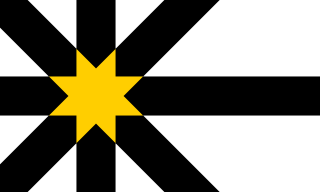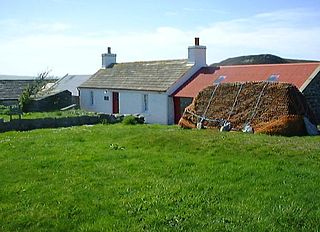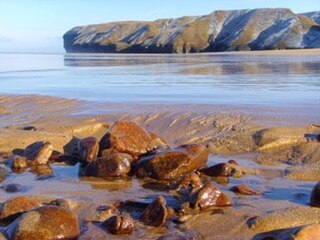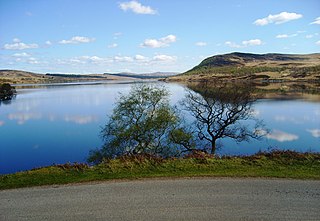
Sutherland is a historic county, registration county and lieutenancy area in the Highlands of Scotland. Its county town is Dornoch. Sutherland borders Caithness and Moray Firth to the east, Ross-shire and Cromartyshire to the south and the Atlantic to the north and west. Like its southern neighbour Ross-shire, Sutherland has some of the most dramatic scenery in Europe, especially on its western fringe where the mountains meet the sea. These include high sea cliffs, and very old mountains composed of Precambrian and Cambrian rocks.

Durness is a village and civil parish in the north-west Highlands of Scotland. It lies on the north coast of the country in the traditional county of Sutherland, around 120 miles north of Inverness. The area is remote, and the parish is huge and sparsely populated, covering an area from east of Loch Eriboll to Cape Wrath, the most north-westerly point of the Scottish mainland.

Helmsdale is a village on the east coast of Sutherland, in the Highland council area of Scotland. The modern village was planned in 1814 to resettle communities that had been removed from the surrounding straths as part of the Highland Clearances.

Lairg is a village and parish in Sutherland, Scotland. It has a population of 891 and is at the south-eastern end of Loch Shin.

Castletown is a village on the north coast of the Highland council area of Scotland, situated near Dunnet Bay. It is within the civil parish of Olrig, where it is the main settlement, and within the historic county of Caithness. The A836 links the village with Thurso and Tongue in the west and with John o' Groats in the east. The B876-A99 links the village with Wick in the southeast. Contrary to the common misconception, the name Castletown is a misnomer as there is no castle within the village limits.

Dunnet is a village in Caithness, in the Highland area of Scotland. It is within the Parish of Dunnet.

Forss Water, known also as Forss River, has its source at the northern end of Loch Shurrey, at grid reference ND042568. About 13 kilometres north of its source the river flows into Crosskirk Bay and the Atlantic Ocean at ND029700. Crosskirk Bay is on the north coast of Great Britain and about 8 kilometres west of the burgh of Thurso, Caithness, in Highland, Scotland. The river marked the eastern extent of the Clan Mackay raid in the Sandside Chase of 1437.

Reay is a village which has grown around Sandside Bay on the north coast of the Highland council area of Scotland. It is within the historic Parish of Reay and the historic county of Caithness.

Bettyhill is a village in the parish of Farr, on the north coast of Scotland.

Strathnaver or Strath Naver is the fertile strath of the River Naver, a famous salmon river that flows from Loch Naver to the north coast of Scotland. The term has a broader use as the name of an ancient province also known as the Mackay Country, once controlled by the Clan Mackay and extending over most of northwest Sutherland.

Armadale is a town within the county of West Lothian in the Central Belt of Scotland. It lies to the west of Bathgate and to the east of Blackridge. Armadale, formerly known as Barbauchlaw, is an ex-mining town which was also known for its brick manufacturing. It is named after Armadale in Sutherland, this estate being owned by Sir William Honeyman who later acquired the land of Barbauchlaw. Primarily a residential community, the town has a number of different public places, a central Mains Street and a series of parks, green spaces and nature reserves, many of which lie atop former mines and industrial areas.

Strathy is a scattered community in Sutherland in the Scottish Highlands. The settlement emerged in the late 19th century as the north coast was populated by families forcibly displaced during the Highland Clearances.
Aultiphurst, in Strathy, Sutherland, is a village in the Scottish Highlands

Farr is a parish in the county of Sutherland in the Scottish council area of Highland. The parish also includes a small hamlet named Farr. The village of Bettyhill lies less than 1 mile to the west of the hamlet along the A836 road.

Westerdale is a scattered crofting village which lies on the River Thurso, located five miles directly south of Halkirk, in Caithness, Highland, Scotland. The B870 road passes through the village.

Skerray is a remote small crofting hamlet and fishing port on the north coast of Sutherland, Scotland. It is located 7+3⁄4 miles by road northeast of Tongue and 40+1⁄4 miles by road west of Thurso. Skerray is home to a community of artists and a group of tree planters.
Swordly is an extremely remote hamlet, located on the Bay of Swordly, on the north coastline of Scotland in Sutherland, Scottish Highlands and is in the Scottish council area of Highland.
Sir William Honyman, 1st Baronet, also known by his judicial title Lord Armadale, was a Scottish landowner, and judge from Orkney. On his lands in Sutherland he was one of the first landlords to evict tenants in order to create sheep farms, a process which grew to become the Highland Clearances.

Loch Naver is a loch in the Farr parish in Sutherland in the Highland council area of northern Scotland. It is situated upon the B873 main road. Upon the loch are also the settlements of Kilbreck, Redhackaistelll and Dailmallhart. Additionally Alltnaharra and Achanaes are nearby. Fishing is very popular on Loch Naver and the River Naver.
Strathnaver Museum is located in Bettyhill, Sutherland, Scotland. It is a fully accredited volunteer-run independent museum which first opened in 1976. It explores the history of north west Sutherland through the context of the Highland Clearances. The Clan Mackay Centre is located on the 1st floor of the main museum building.



















